Nano reef fish are a great place to start your reef journey because they represent some of the most widely available saltwater fish in the trade. They are also inexpensive and hardy, making them perfect for beginners looking to dip their toes into the reef world.
Choosing the right nano reef fish can be a bit of a challenge because not all nano fish are reef safe. Let’s take a look at what a nano reef tank is and why each of these fish work for one!
What is a Nano Reef Tank?
A nano reef tank is a reef aquarium 30 gallons or below in size. While they can be as small as 5 gallons I recommend staying away from such small setups unless you’re already an expert. Reef invertebrate inhabitants typically need impeccable water quality and stable conditions, both of which can be thrown off from a simple overfeeding in such a tiny tank.
Each of the nano reef fish in this list are fully reef safe. Reef safe fish are those that won’t disturb or eat sessile invertebrates such as corals, sponges, and anemones. Many marine fish like Dwarf Angelfish will graze on and kill these unmoving sources of protein.
Some, such as the Basslets, may eat small shrimp and other desirable invertebrates, however.
The 10 Best Small Saltwater Fish for Nano Reef Tanks
Here are 10 of our favorite nano reef fish:
Ocellaris Clownfish
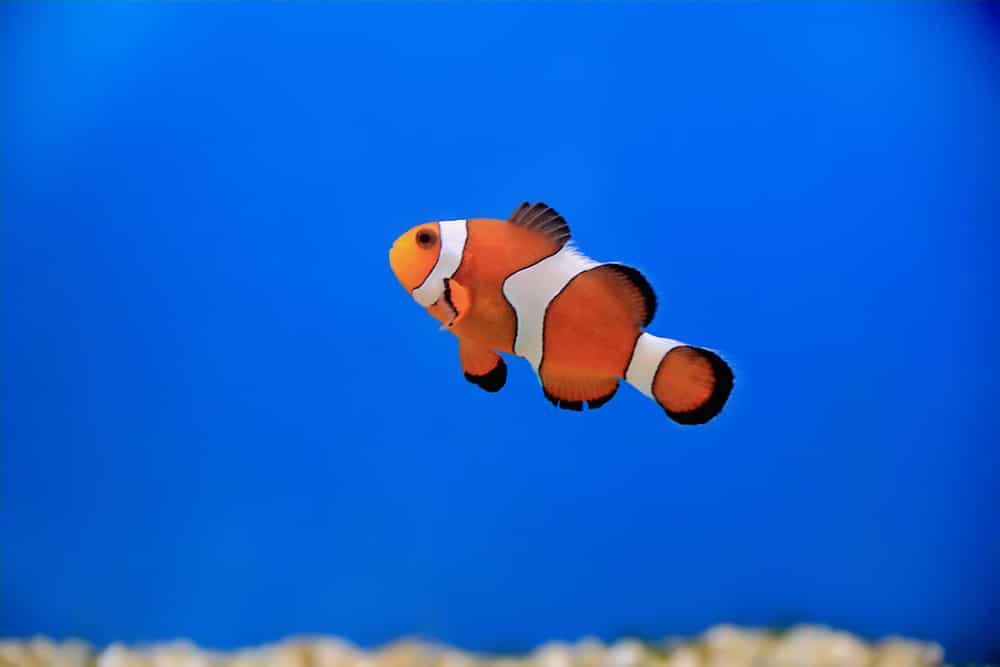
Also known as the False Percula Clownfish, the Ocellaris or Common Clown is the best nano fish for aquarists looking for their own Nemo. Their wobbly swim style is endearing as are their bold nature and eager feeding habits.
They are nearly identical to the more sensitive and expensive Percula Clownfish at a casual glance. However, Ocellaris are distinguished by their stripes and eye color.
While Perculas have wide dark edges to their white bands, Ocellaris Clownfish have thin edges. Also, their eyes are a darker shade of orange compared to the lighter tone of Perculas.
Since they are some of the most popular marine aquarium fish in the world, Common Clownfish are easily found as hardy, inexpensive captive bred youngsters.
And just like their wild cousins, they will bond to several species of sea anemone, eventually feeding and defending their living homes from predators and other Clownfish. Even the Easiest of Anemones is a challenge for beginners, however.
They are demanding in terms of water quality, stability, and lighting intensity, so think carefully before purchasing one!
- Scientific Name: Amphiprion ocellaris
- Origin: IndoPacific
- Size: 2 to 3 inches
- Favored Anemones: Heteractis magnifica, Stichodactyla gigantea, Stichodactyla mertensii, Entacmaea quadricolor
- Price: $15-20
Royal Gramma
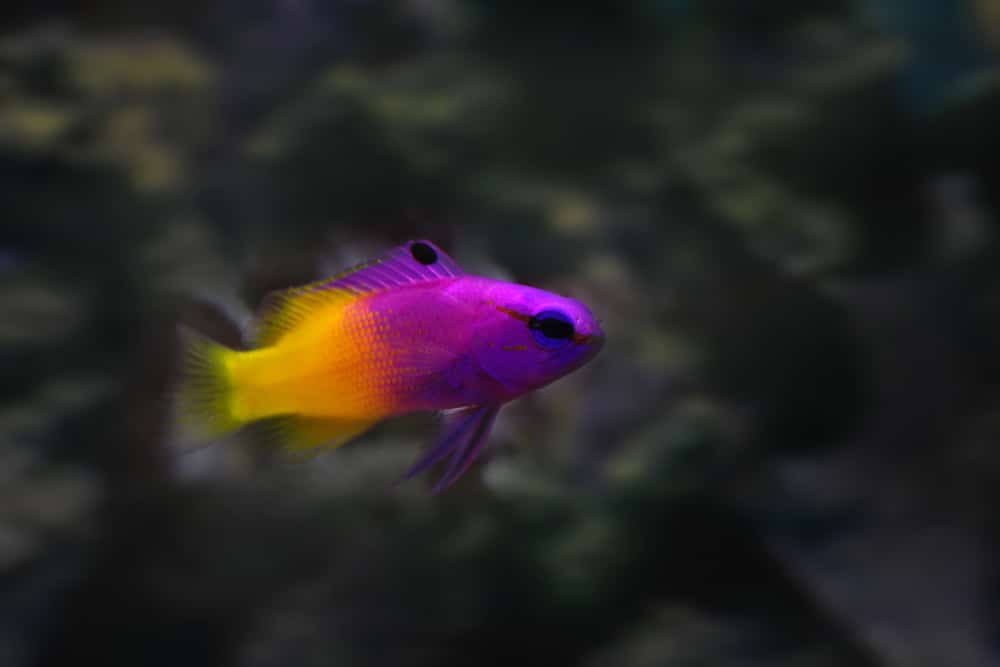
Gramma or Fairy Basslets are striking fish from the Western Atlantic Ocean. Two species regularly make it into the trade but the rarer Blackcap Basslet shares the same care habits as the Royal Gramma.
As a deepwater fish Royal Gramma should have plenty of places to avoid harsh, direct lighting. They absolutely must have at least one cave or grotto, and preferably several to choose from.
Once they have chosen their cave they will rarely leave except to feed, briefly snapping up food from the water column before darting back to their home.
While small they can be feisty in defense of their cave, especially towards similarly colored and shaped fish, like their cousin the Black Capped Basslet.
Or worse, other Royal Grammas. Contrary to popular belief, they can be kept together and even in groups. However introductions must be simultaneous and done in an aquarium spacious enough for each fish to have a cave.
Once a Royal Gramma has staked its claim it will viciously attack another Gramma – and unless the interloper has its own cave to retreat to, it will end up dead. If you intend on keeping multiples also ensure they are introduced while young.
- Scientific Name: Gramma loreto
- Origin: Western Atlantic
- Size: 3 inches
- Price: $15-30
Neon Goby
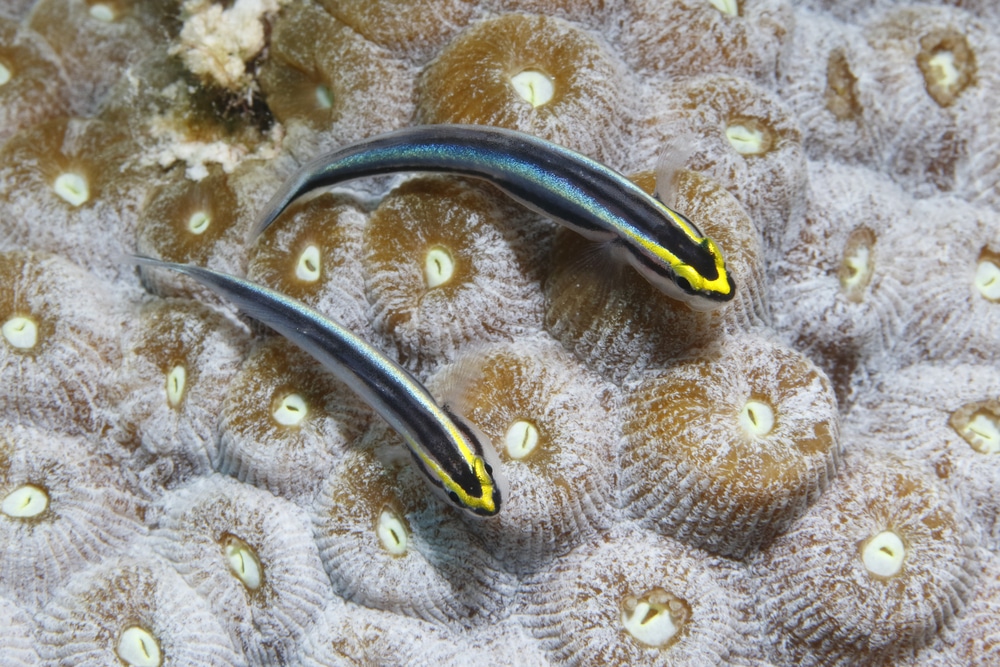
While there are a handful of similarly patterned species that sometimes show up in the aquarium trade Elacatinus oceanops is the Neon Goby you’re most likely to encounter.
In the wild Neon Gobies set up cleaning stations that even attract the attention of large reef predators like Groupers and Moray Eels. Despite being hundreds of times larger the predatory fish will simply open their mouths wide while the gobies pick away food debris from between teeth and ectoparasites on skin.
It’s not recommended to duplicate this in aquaria since Neon Gobies are from a specific region of the world and would simply be eaten by many large predators. However they can be kept with nano reef fish and medium sized fish like Centropyge Angelfish and Butterflyfish.
Neon Gobies also accept prepared, live, and frozen foods like Brine Shrimp and Tubifex worms with relish. They are even bred fairly often in captivity, bringing their price down even further!
While somewhat territorial towards one another and other Gobies for the best perching spot, Neon Gobies can still be kept in groups as well as singly.
- Scientific Name: Elacatinus oceanops (+ related species)
- Origin: Caribbean
- Size: 2 inches
- Price: $10-20
Chalk Bass
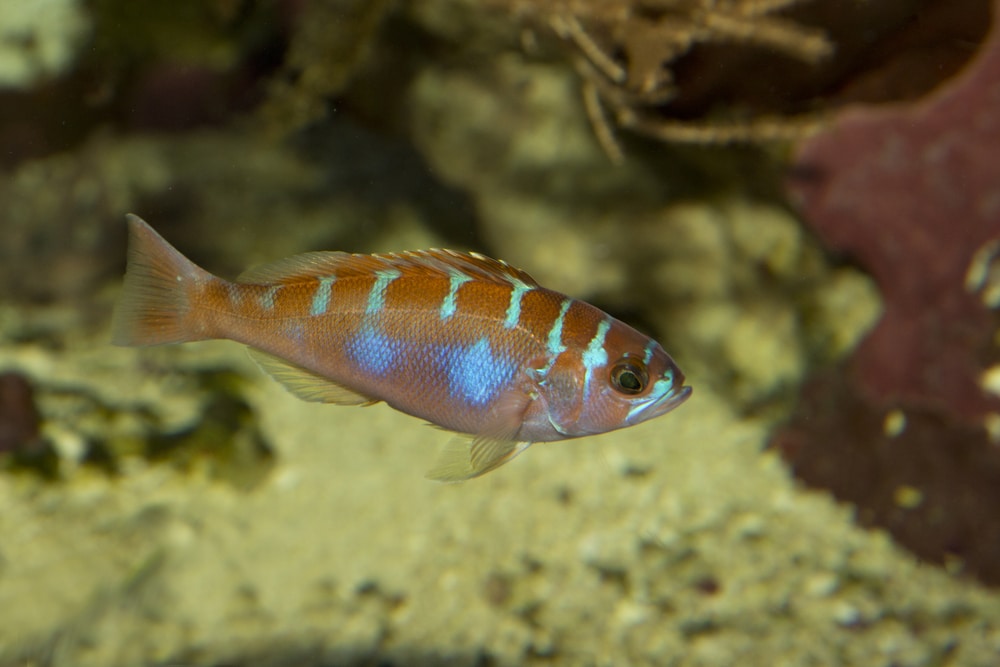
Chalk Bass are part of the Serranidae family, a group that includes the Giant Grouper, one of the largest bony fish on earth! Much like its massive cousin, Chalk Bass are also predators. Or to be precise, micro-predators, feeding on fish fry, shrimp, plankton, and small meaty prey items.
Chalk Bass have an attractive, if muted, palette of pastel pinks and orange tones. They are also sociable, though occasionally aggressive towards one another, especially if two pair off and a third becomes the odd fish out. It’s much better to keep 1, 2, or at least 5 Chalk Bass together.
Fortunately they are hardy and resistant to the minor swings on water chemistry and temperature that come with setting up a new aquarium. This makes them excellent first fish for beginner nano reef fish keepers.
Chalk Bass may eat tiny shrimp but are considered reef safe. They will also leave larger invertebrates like Blood Red Fire and Coral Banded Shrimp alone.
- Scientific Name: Serranus tortugarum
- Origin: Western Atlantic
- Size: 2 to 3 inches
- Price: $10-20
Mandarin Dragonet
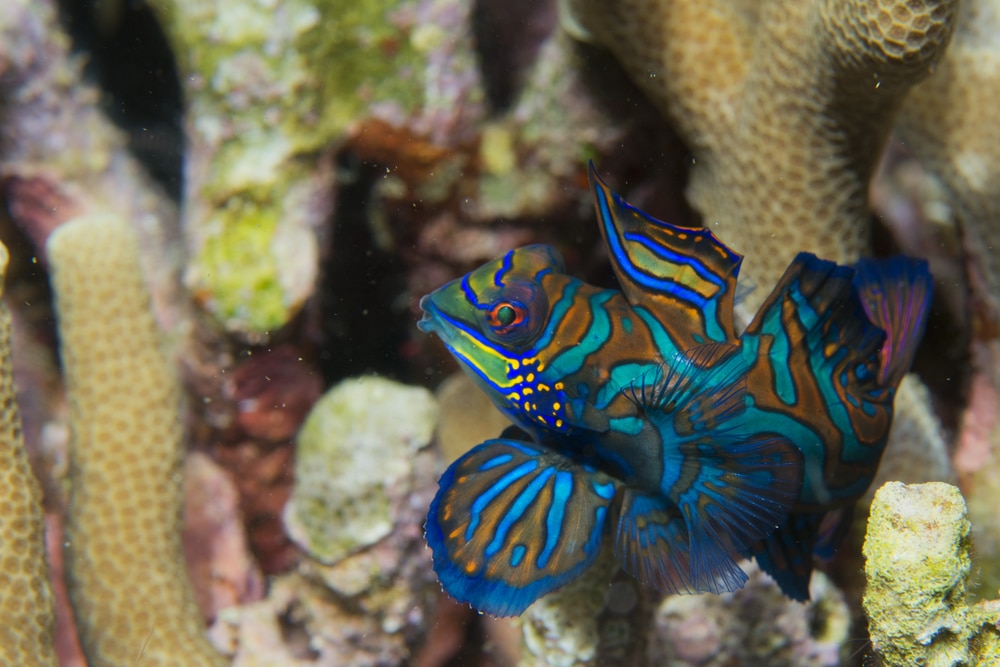
Mandarin Dragonets are stunning even for the brilliantly colored world of saltwater aquaria. They are bottom dwellers that crawl on well developed pelvic fins among rocks and coral. While scaleless and slow they have a poisonous outer mucus coating that deters predators.
Mandarin Dragonets are a little more challenging to keep than the other fish on this list because they don’t always accept prepared or even frozen food. They are specialist copepod hunters in the wild, picking through coral and detritus for the tiny crustaceans.
Copepods are usually found in mature aquariums with a healthy live rock and coral ecosystem. However there may not be enough to fully sustain a Mandarin Dragonet. Supplementing their diet with fresh copepods is the best way to keep them healthy. Copepods will also be eaten by the other fish and invertebrates in your nano reef tank!
As an aside, both the Mandarin Dragonet and its cousin the Psychedelic Mandarin Dragonet are the only vertebrates in the world that create true blue pigments. Every other fish, amphibian, reptile, bird, and mammal instead relies on what’s called structural coloration, twisting light in subtle ways to create the illusion of blue!
No one is sure why Dragonets rely on their biologically “expensive” true blue pigments over the simpler route to blue other animals have taken.
- Scientific Name: Synchiropus splendidus
- Origin: Western Pacific
- Size: 3 inches
- Price: $20-30
Six Line Wrasse
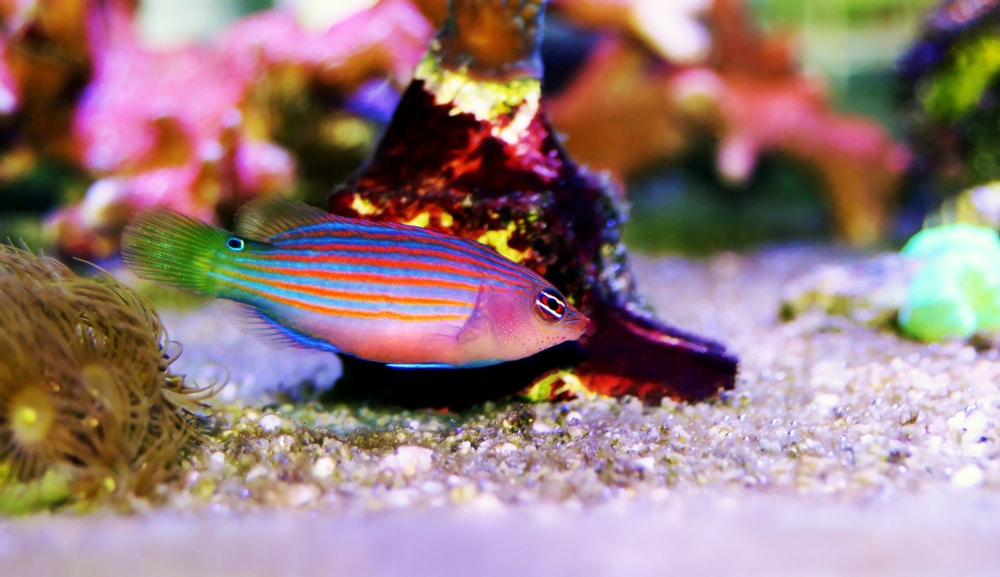
While many Wrasse species can reach several feet in length Six Line Wrasse are a dwarf species perfectly suited as nano reef fish!
While hardy once fully acclimated they stress easily during shipping and should not be purchased immediately on arrival to an aquarium store. It’s better to place a deposit and give the new Wrasse a week to settle in case it eventually dies from stress.
Like their larger cousins Six Line Wrasses are invertebrate hunters and prefer feeding on small shrimp, worms, and tiny snails (including the problematic Pyramidellid snails and Bristleworms). They have well developed teeth to crunch through shells and exoskeletons and enjoy frozen foods like Brine Shrimp and Copepods to supplement their foraging.
They are a semi-aggressive fish, especially towards other Six Line Wrasses, and should be the last fish added to an aquarium to mitigate this. They are known to even act as cleaner fish but very rarely.
- Scientific Name: Pseudocheilinus hexataenia
- Origin: IndoPacific
- Size: 3 inches
- Price: $20-30
Yellow Watchman Goby
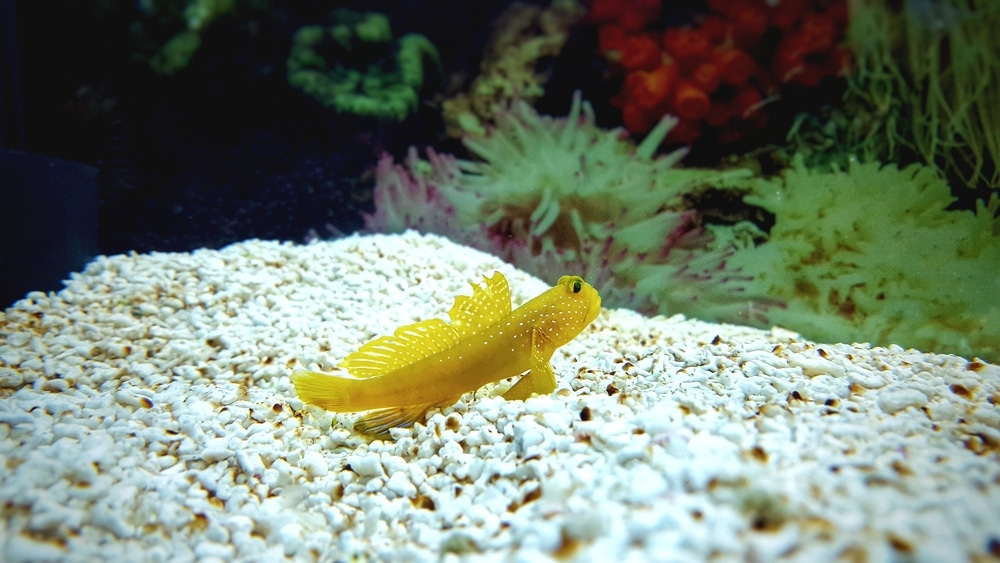
Yellow Watchman Goby are popular nano reef fish that get their name from their habit of perching on the lip of a burrow and observing all that happens around them. Anything threatening causes them to vanish, dashing below the substrate to safety.
Watchman Gobies should be kept in tanks with deep sand substrates for them to dig into. They are hardy in terms of water chemistry and will accept a wide variety of fresh and prepared food options.
They are also known as Yellow Prawn Gobies because they form symbiotic relationships with Pistol Shrimp. Both species prefer to live in burrows in sandy substrates. Watchman Gobies have excellent vision but no defenses other than fleeing. Pistol Shrimp have poor eyesight but pack a defensive punch using their specialized claws.
The two animals are often found together in nature sharing a burrow and pairing their gifts to best effect. While duplicating this relationship in aquaria is a little difficult to pull off it certainly can be done with some pre-planning or the purchase of a wild caught Goby-Shrimp pair.
- Scientific Name: Cryptocentrus cinctus
- Origin: Western Pacific
- Size: 3 to 4 inches
- Price: $15-30
Swissguard Basslet
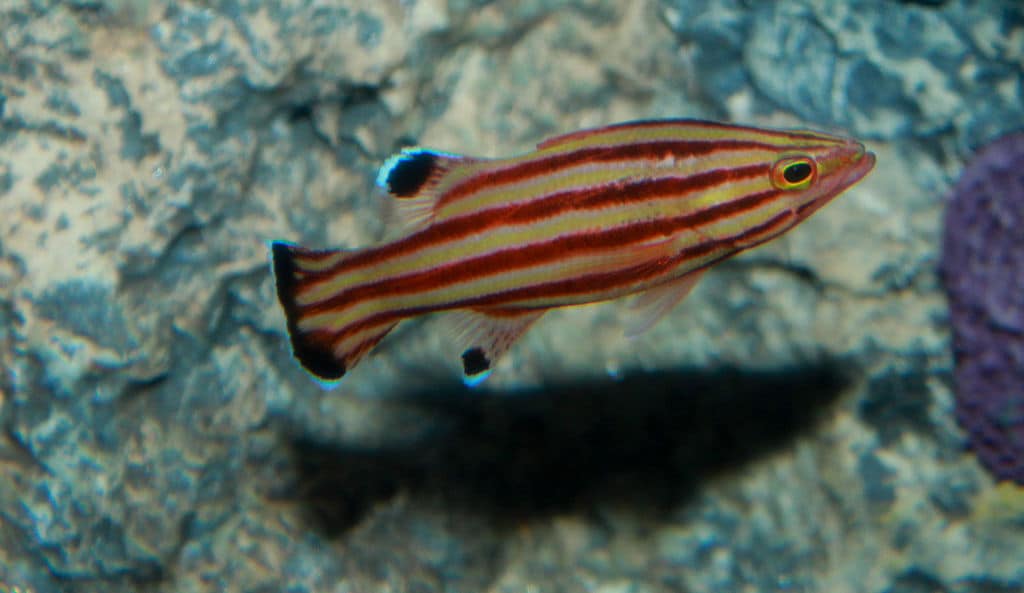
Swissguard Basslets are tiny versions of true Bass, much like the Chalk Bass. Also found in the Western Atlantic, these Basslets are considered semi-aggressive compared to their mild mannered relatives. Given their territorial nature and high price, a single Swissguard Basslet per nano reef is recommended.
Like all Bass the Swissguard Basslet is a carnivore, feeding on tiny fish and crustaceans in nature. They should be offered a mix of protein rich flakes and pellets as well as frozen and live food for variety.
While relatively rare and pricey the Swissguard Basslet is not delicate and is an excellent addition to new and established nano reef aquariums! Like all Basslets they are a threat to small shrimp but entirely reef safe.
- Scientific Name: Liopropoma rubre
- Origin: Western Atlantic
- Size: 3 inches
- Price: $150-200
Fire Goby
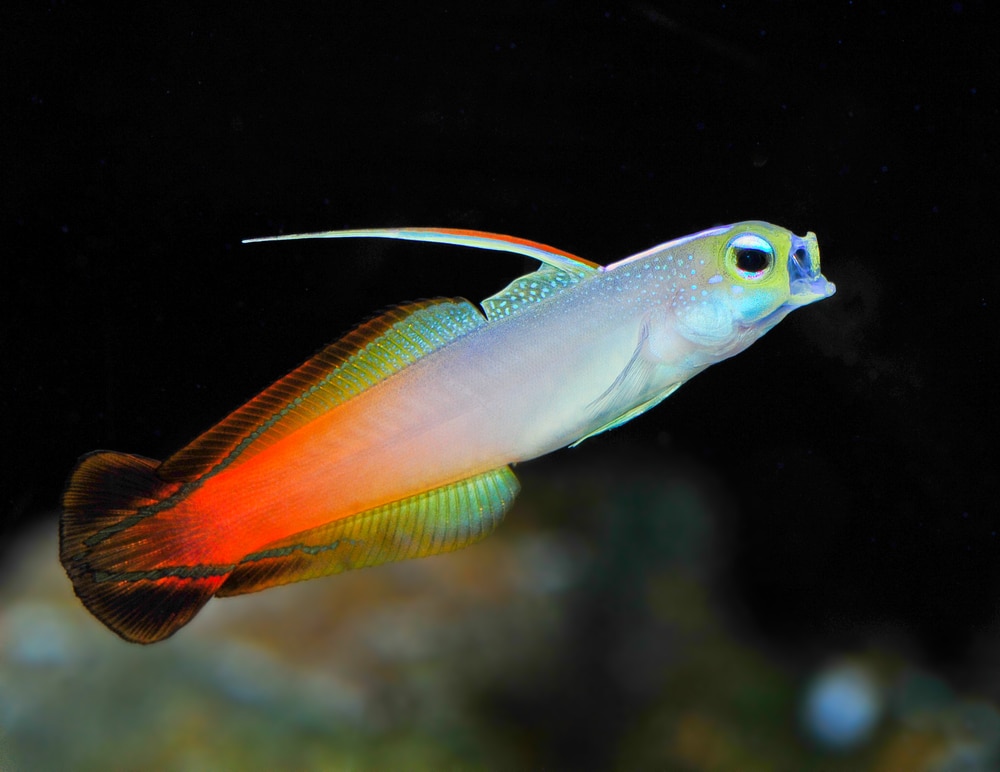
Fire Gobies have several common names, including Firefish, Firefin Goby, and Magnificent Darter. They are very popular in the trade and have identical care requirements to their close relation the Purple Firefish (Nemateleotris decora).
All Fire Gobies hang around near the bottom to midwater levels, picking out suspended food particles like plankton or Brine Shrimp Nauplii from the water column. They are peaceful towards other inhabitants and are excellent nano reef fish for a community tank.
Getting Fire Gobies to live in groups is hit or miss because they form loose associations in nature rather than true schools. Each Goby is within eyesight of several companions and they rely on their shared vision in case predators lurk nearby.
However they all have their own bolthole that they viciously defend from one another. In the confines of even a larger aquarium Fire Gobies may harass each other to death. Therefore no more than one should be kept in a nano reef tank.
- Scientific Name: Nemateleotris magnifica
- Origin: IndoPacific
- Size: 3 inches
- Price: $10-20
Banggai Cardinalfish
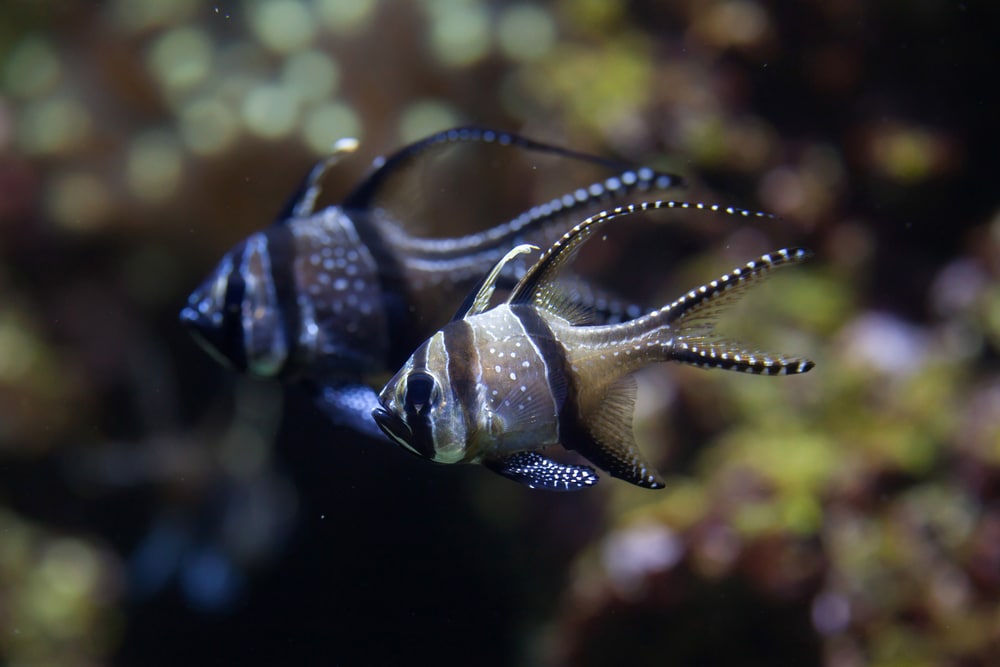
Banggai Cardinalfish are plankton and invertebrate feeders from Indonesia that are slowly becoming more popular for nano reef tanks. Their bold black striped pattern is an adaptation to match their habit of hiding among the spines of sea urchins when threatened.
However they don’t need to be kept with urchins and do well either as pairs or groups of up to 8 individuals. Banggai Cardinalfish tend to form loose associations that group into a school and then break apart on occasion but are peaceful towards one another.
If you’re interested in breeding marine nano reef fish the Banggai Cardinalfish may be one of the best species to work with. Since they are found only in one small region of the world they are highly threatened by collection for the aquarium trade.
They do breed readily in captivity, however, and there is a ready market for these striking nano fish. They breed in pairs and the male picks up the eggs to mouth brood, similar to many Cichlids and Betta species.
Once hatched the young are on their own but are large enough to eat Brine Shrimp Nauplii and other easily obtained live food items!
- Scientific Name: Pterapogon kauderni
- Origin: Banggai Island, Indonesia
- Size: Up to 3 inches
- Price: $20-30

